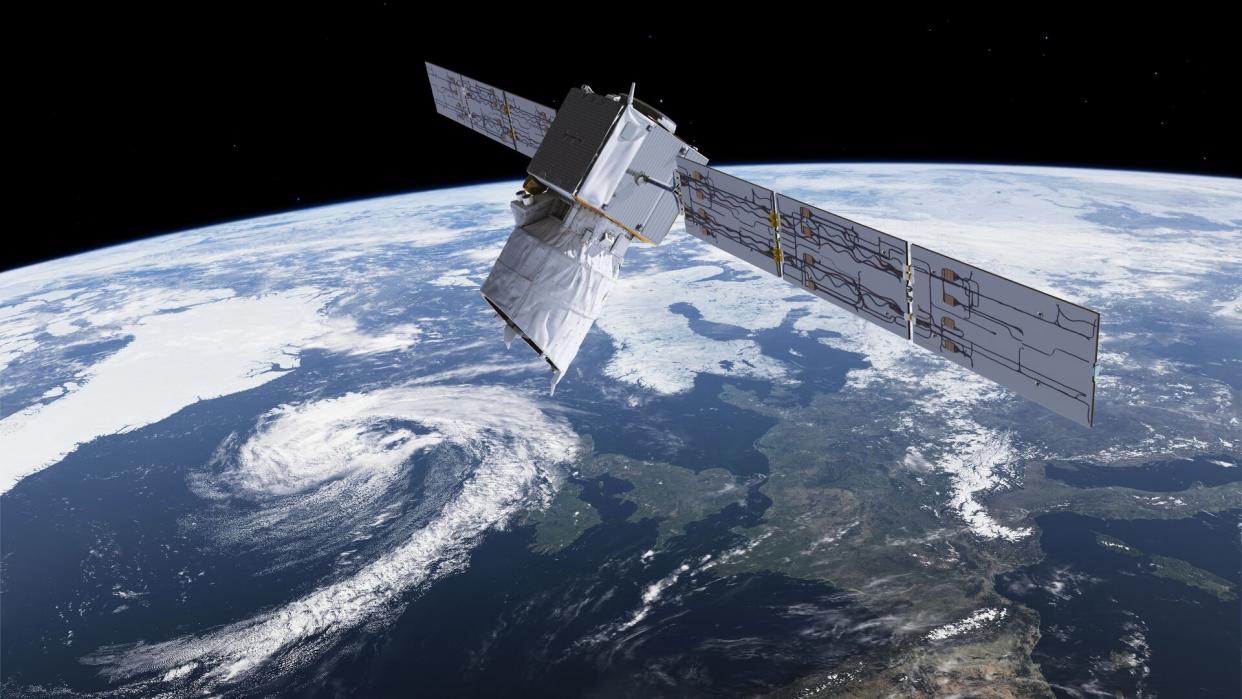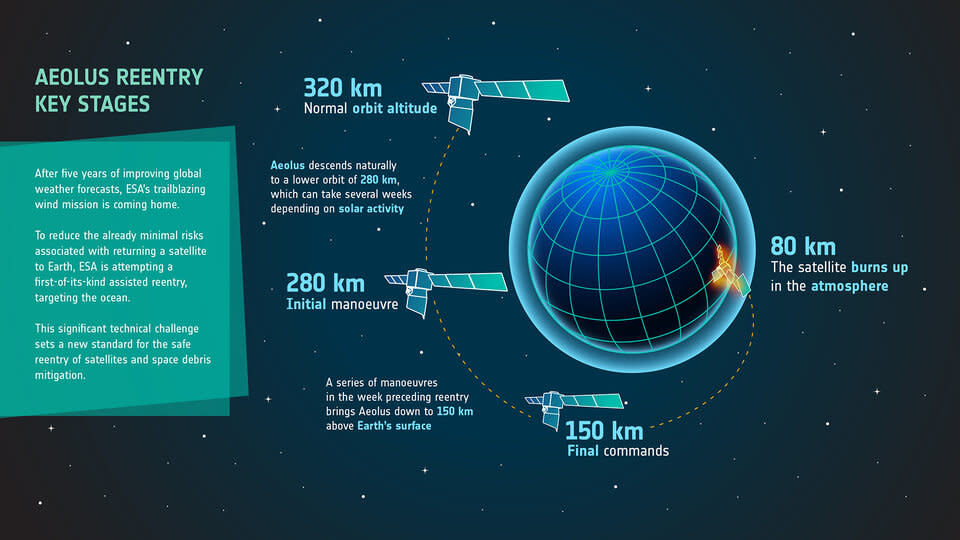European satellite will fall to Earth today in landmark 'assisted reentry'

A European satellite will make spaceflight history today (July 28), if all goes according to plan.
The European Space Agency's (ESA) Aeolus spacecraft is scheduled to reenter Earth's atmosphere this evening, capping a four-day orbit-lowering campaign that could blaze a new trail for satellite operators.
"This is quite unique, what we're doing. You don't find really examples of this in the history of spaceflight," Holger Krag, head of ESA's Space Debris Office, said during a press briefing on July 19. "This is the first time to our knowledge [that] we have done an assisted reentry like this."
Related: When and where will Europe's Aeolus wind satellite fall to Earth this week?
Aeolus was a pioneer in life as well. The 3,000-pound (1,360 kilograms) satellite launched in August 2018 to monitor Earth's winds, something that had never been done in detail from orbit.
The spacecraft's data have helped researchers improve their climate models and weather forecasts, ESA officials have said. And there is more of this data than the mission team expected: Aeolus operated for nearly 4.5 years, about 18 months longer than its planned scientific lifetime.
But the spacecraft eventually began running low on fuel. Rather than let Earth's atmosphere drag Aeolus down in a chaotic fashion, as is the norm for orbiting satellites, mission team members decided to take a more active role in the spacecraft's demise. They orchestrated the de-orbit campaign, which aims to ensure that Aeolus burns up over an empty stretch of the Atlantic Ocean, posing no threat to people and buildings on the ground.
That threat, though small, is real whenever a satellite falls uncontrolled to Earth: In general, about 20% of a spacecraft's mass survives the fiery trip through the atmosphere and hits terra firma (or, more commonly, ocean waters). And there's a lot of stuff up there just waiting to come down.
"Today, we have 10,000 spacecraft in space, of which 2,000 are not functional. In terms of mass, we are speaking about 11,000 tons," Krag said at the July 19 press conference.
About 100 tons of human-made space junk fall to Earth each year, and large objects reenter our atmosphere about once a week on average, he added.
Guided reentries, which are commonly performed by rocket stages after orbital launches, could help make a dent in this space-junk problem. And the Aeolus team hopes to lead the way in this respect.
Aeolus' reentry campaign "sets a new precedent for safe spacecraft operations and sustainable spaceflight, for both future missions and those already in orbit," ESA's Rosa Jesse wrote in a blog post last month.

RELATED STORIES:
— Satellite will die by fire as 1st-of-its-kind operation sends it plummeting down to Earth
— Listen to music 'written' by doomed Aeolus wind-studying satellite (video)
— Here's how ISS astronauts jettison old space station hardware (video)
Aeolus studied Earth's winds from an altitude of about 200 miles (320 kilometers). The spacecraft began falling from this orbit on June 19, and the mission team started accelerating the process five weeks later.
On Monday (July 24), Aeolus performed two engine burns that lasted a total of 37.5 minutes and lowered its altitude by about 19 miles (30 km), to 155 miles (250 km). The campaign picked up again Thursday (July 27), with four planned orbit-lowering maneuvers.
One final maneuver is planned for today, with reentry expected about five hours after its conclusion, ESA officials have said. At the moment, however, it's too soon to predict when and where Aeolus will come down, and which parts of Earth might be able to see the satellite's blazing death dive. We'll just have to keep our eyes peeled for updates from ESA and the Aeolus team.
It's also possible that the assisted reentry won't go entirely according to plan, and that Aeolus' reentry will end up being at least partially uncontrolled. But, even in that case, the current campaign would still have been worth the effort, ESA officials said.
"Successful or not, the attempt paves the way for the safe return of active satellites that were never designed for controlled reentry," the agency's Peter Bickerton wrote in a July 19 blog post.

